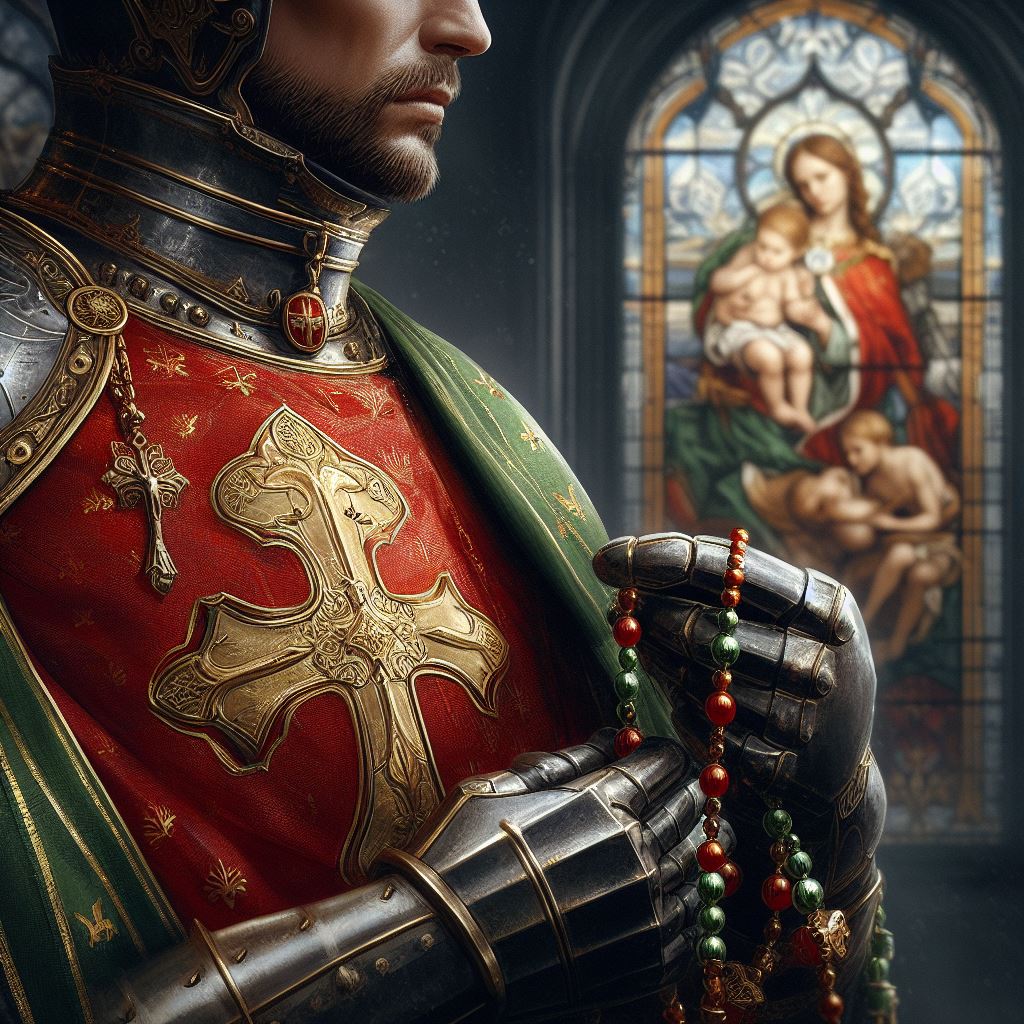The Rosary, a profound prayer deeply rooted in the Catholic tradition, involves the rhythmic repetition of specific prayers while meditating on pivotal events in the lives of Jesus Christ and the Virgin Mary. This sacred practice has a rich history dating back to the early Middle Ages, marked by the contributions of various religious figures who shaped its evolution. Delving into the intricacies of the Rosary reveals a tapestry woven with spiritual significance and devotion.
History of the Rosary:
Early Beginnings: The origins of the Rosary can be traced to medieval times when devout individuals engaged in the recitation of 150 Psalms. For those who couldn’t read, the substitution of Psalms with the repeated recitation of the “Our Father” prayer became a common practice.
Emergence of Marian Psalter: In the 12th century, this prayer practice transformed into the “Marian Psalter,” a compilation of 150 Hail Mary prayers dedicated to honoring Mary. It gained popularity, particularly among monastic communities seeking a profound connection with the divine through devotion to the Virgin Mary.
St. Dominic and the Rosary: The attribution of the spread of the Rosary to St. Dominic in the 13th century is steeped in legend. According to tradition, Mary appeared to St. Dominic, presenting the Rosary as a potent tool to combat heresies and encourage meditation on the life of Christ.
Structure and Mysteries:
The Rosary is a structured prayer comprising specific beads and is divided into four sets of Mysteries, each shedding light on different events in the lives of Jesus and Mary. These Mysteries include:
Joyful Mysteries:
- Annunciation:
- Event: The angel Gabriel announces to Mary that she will conceive the Son of God.
- Meditation: Reflect on Mary’s humility and acceptance of God’s plan.
- Visitation:
- Event: Mary visits her cousin Elizabeth, who is also miraculously pregnant with John the Baptist.
- Meditation: Contemplate Mary’s joy and the recognition of Christ’s presence by John in Elizabeth’s womb.
- Nativity:
- Event: Jesus is born in Bethlehem.
- Meditation: Ponder the humility of Christ’s birth and the joy it brings to the world.
- Presentation in the Temple:
- Event: Mary and Joseph present Jesus in the Temple, where Simeon prophesies about Jesus’ role.
- Meditation: Consider the consecration of Jesus to God and Mary’s faithful obedience.
- Finding in the Temple:
- Event: Mary and Joseph find twelve-year-old Jesus in the Temple discussing with scholars.
- Meditation: Reflect on the anxiety of Mary and Joseph and Jesus’ early understanding of His mission.
Sorrowful Mysteries:
- Agony in the Garden:
- Event: Jesus prays in Gethsemane, facing the agony of His impending crucifixion.
- Meditation: Contemplate Jesus’ human struggle and surrender to God’s will.
- Scourging at the Pillar:
- Event: Jesus is brutally whipped before His crucifixion.
- Meditation: Reflect on the physical and emotional suffering Christ endured for humanity.
- Crowning with Thorns:
- Event: Jesus is mockingly crowned with thorns by Roman soldiers.
- Meditation: Ponder the humiliation and mockery Jesus endured as the King of Kings.
- Carrying of the Cross:
- Event: Jesus carries His cross to Calvary.
- Meditation: Walk with Jesus in His journey, reflecting on the weight of human sins.
- Crucifixion:
- Event: Jesus is crucified, offering His life for the salvation of humanity.
- Meditation: Contemplate the profound sacrifice of Jesus on the Cross and the redemption it brings.
Glorious Mysteries:
- Resurrection:
- Event: Jesus rises from the dead.
- Meditation: Reflect on the triumph of life over death and the hope brought by the Resurrection.
- Ascension:
- Event: Jesus ascends into heaven.
- Meditation: Contemplate the glorification of Jesus and His continued presence in our lives.
- Descent of the Holy Spirit:
- Event: The Holy Spirit descends upon the apostles at Pentecost.
- Meditation: Ponder the transformative power of the Holy Spirit in the early Church.
- Assumption of Mary:
- Event: Mary is assumed into heaven, body and soul.
- Meditation: Reflect on Mary’s unique role and her share in the glory of her Son.
- Coronation of Mary:
- Event: Mary is crowned as Queen of Heaven.
- Meditation: Contemplate Mary’s exalted position and her intercessory role in heaven.
Luminous Mysteries:
- Baptism of Jesus:
- Event: Jesus is baptized by John the Baptist in the Jordan River.
- Meditation: Reflect on the manifestation of the Holy Trinity and Jesus’ public ministry initiation.
- Wedding at Cana:
- Event: Jesus performs His first miracle, turning water into wine at a wedding.
- Meditation: Contemplate Mary’s intercession and Jesus’ manifestation of His divine power.
- Proclamation of the Kingdom:
- Event: Jesus preaches about the Kingdom of God.
- Meditation: Reflect on Jesus’ teachings about the reign of God in our lives.
- Transfiguration:
- Event: Jesus is transfigured on the mountain, revealing His divine glory.
- Meditation: Ponder the revelation of Jesus’ divinity and the significance for His disciples.
- Institution of the Eucharist:
- Event: Jesus institutes the Eucharist at the Last Supper.
- Meditation: Contemplate the profound gift of the Eucharist as the source of spiritual nourishment.
How to Pray the Rosary:
- Begin with the Sign of the Cross.
- Recite the Apostle’s Creed.
- On the Crucifix, pray the Our Father.
- On the next three beads, pray three Hail Marys each for faith, hope, and charity.
- On the first large bead, announce the first mystery and pray the Our Father.
- On each of the next ten small beads, pray a Hail Mary while meditating on the mystery.
- After the decade, pray the Glory Be.
- Repeat steps 5-7 for each decade, announcing the next mystery.
- After completing all five decades, conclude with the Hail Holy Queen and the Sign of the Cross.
The Rosary holds immense cultural and spiritual significance within the Catholic faith. Beyond its seemingly repetitive nature, the prayer serves as a gateway for believers to enter a state of profound meditation and contemplation. It is not merely a rote exercise but a purposeful ritual designed to facilitate a deep and structured connection with the divine, providing a framework for spiritual reflection.
The Profound Power of Praying the Rosary: A Spiritual Journey of Grace and Reflection
The Rosary, a cherished form of prayer in the Catholic tradition, has transcended centuries, offering believers a transformative journey of grace, meditation, and spiritual reflection. This article delves into the profound power of praying the Rosary, exploring its historical significance, structure, and the myriad spiritual benefits it bestows upon those who embrace this sacred practice.
Historical Significance: The roots of the Rosary can be traced back to the medieval ages, evolving from the practice of reciting 150 Psalms. As laypeople substituted the Psalms with repetitive prayers, the Rosary gradually emerged. In the 12th century, it took the form of the “Marian Psalter,” a series of Hail Mary prayers honoring the Virgin Mary. St. Dominic, in the 13th century, is traditionally credited with its widespread dissemination, guided by a vision from Mary to combat heresies and promote meditation on the life of Christ.
Structure of the Rosary: The Rosary comprises specific prayers and is divided into four sets of Mysteries, each highlighting pivotal events in the lives of Jesus and Mary. The Joyful, Sorrowful, Glorious, and Luminous Mysteries guide believers through a journey of meditation and contemplation, fostering a deep connection with the divine.
Spiritual Benefits of Praying the Rosary:
- Meditative Reflection:
- The repetitive nature of Rosary prayers provides a structured framework for meditative reflection.
- Believers can immerse themselves in the life of Christ and the Virgin Mary, finding solace in the contemplation of their virtues.
- Peace and Tranquility:
- The rhythmic recitation of prayers offers a sense of peace and tranquility, creating a sacred space for communion with the divine.
- Many find the Rosary to be a source of comfort during challenging times, bringing a profound sense of serenity.
- Connection with the Divine:
- Praying the Rosary fosters a deep connection with God, Jesus, and the Blessed Mother.
- Believers often describe feeling a spiritual presence and guidance, strengthening their faith and sense of divine companionship.
- Community and Unity:
- The communal aspect of praying the Rosary fosters unity among believers.
- Group Rosary sessions create a sense of solidarity, as individuals join together in a shared spiritual journey.
- Transformation of Heart:
- Regular practice of the Rosary is believed to lead to a transformation of the heart.
- Many attest to experiencing increased virtues, such as patience, compassion, and a deeper understanding of the Christian message.
The Rosary stands as a powerful and timeless prayer, offering believers a sacred path to spiritual growth, meditation, and communion with the divine. Its historical roots, coupled with the structured reflection on the Mysteries, make it a cherished tradition that continues to inspire and uplift the hearts of millions around the world. As believers embark on the journey of praying the Rosary, they discover not only a source of grace but also a profound connection to the divine tapestry of faith.









